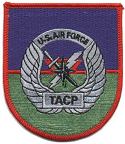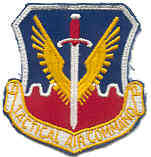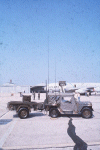 |
 |
Brief Overview of what the FAC's were / are all about.
The Forward Air Control mission dates back to World War II. Unfortunately information from that time period is sketchy. During Korea and Vietnam the Ground FAC mission came unto its own. I will attempt to fill in as many blanks as possible. During the Vietnam conflict, the role of the Forward Air Controller was redefined. Not always were they flying low over the jungle looking for targets.
Now they were on the ground, attached to ground maneuver units (The Army, Grunts, Foot Sloggers, Crunchies .. take your pick). Their mode of transport was the M-151 Ford jeep with a heavy communications pallet in place of the back seats. To keep this radio equipment in good working order a maintenance tech, a (AFSC =304X4 Depot Level Radio Repairman), was assigned to the "MRC-108 System". This ROMAD (Radio Operator, Maintainer And Driver, an enlisted guy usually an E2 or E3) was to assist a FAC (an officer, usually a Lieutenant or Captain) in getting around the country and more or less stay out of harms way in order to call in air strikes in support of the Unit that was under fire.
During the early years of this mission, the personnel who did it were not chosen because they were Gung-ho or highly motivated. It was their turn. Pure and simple. Some of the enlisted ROMADs made a name for themselves and others were just faces in the crowd.
The 275X0 AFSC, (Tactical Air Command And Control Specialist) was separated from the 304X4 AFSC in 1977. This new AFSC was established because ROMAD duties were being performed by 304X4's even though these duties were not reflected in their specialty description.
This became a concern because less than thirty three percent of ROMAD duties involved radio maintenance, causing training problems and loss of proficiency in actual 304 duties. This coupled with no formal training standard developed for ROMADs, prompted a proposal from "The Gang of 5" (Suarez, Thurman, Wachs, Fiscus and Mack) to Air Staff to create an AFSC that directly handled ROMAD duties. Also lobbying for us was Col. "Rumbles" Ruhman (Shorties Boss), Capt. Garrison the Tactical Air Command Point man and Maj. "Tony" Namlick the AGOS point man.
Effective 30 April 1977, AFSC 275X0 was established to perform ROMAD duties exclusively. When the award of the AFSC took place, the Air Force needed people to man the new positions. Who better than the people that had been doing it prior to April?. Most of the personnel grabbed were either returning from overseas or were in overage slots in the 304 job. Most of the "New" ROMADs were not really happy about being drafted like this. The 304 personnel parachute qualified were able to move freely from TACP (Tactical Air Control Party FAC + ROMAD + M-151 = TACP) to CCT (Combat Control Team, overqualified Air traffic controllers).
The CCT was under the 24 man team concept. 6 Positions for 304s for radio repair and 18 Air Traffic controllers. The CCT were authorized berets, "High Speed" (Newer) equipment, and other amenities such as pay bonuses. The TACPs were treated rather like step children by Tactical Air Command. In 1979, Military Airlift Command (Owners of CCT) decided to eliminate the 304 slots. Now the 304s had to make a quick choice, find a job as a radio repairman, cross train to the CCT or cross train to the TACP. Most took the TACP. Since its inception in 1977, the 275X0 (1C4X0) has made a place for himself in history. The next time you watch CNN and see an air strike going into an enemy target, see if you can see the guy wearing Air Forces stripes and a microphone stuffed into his face.
 |
A Updated Brief
History of the FAC
as provided from the web in July of 2000
 |
The U.S. Air Force has dubbed us 1C4X1's. The 1C shows that we are in a Command and Control career field. The 4 gives the specific job in the Command and Control career field. The X is used for all around the career field, but, for an individual it would be one of five numbers (1,3,5,7, or 9) to show the current skill level of that individual. Finally, the 1 gives more specifics about the job. In words, 1C4X1 means Tactical Air Command and Control Specialist (TACCS).
We are normally stationed away from the Air Force. In almost all of our available worldwide duty locations, we are stationed at an Army installation. In fact, at every maneuver division the Army has, there is a squadron of ROMADs. This is so we can coordinate with the Army on matters of Close Air Support. In the field, or at war, we are with the Army to support the scheme of maneuvers with Air Support.
A ROMAD is an Air Force enlisted man (no females or officers in this career field) assigned to an Army maneuver unit. Here's how it works. The US Air Force assigns ROMADs or 1C4's to the TACP (Tactical Air Control Party Flight). Our mission is to advise, assist, and control air assets in support of the US Army, usually in close proximity to friendly troops. In fact, the ROMADs primary mission is CAS (Close Air Support). ROMADs will move forward with a Scout or COLT team, locate and mark the target, and 'control' the CAS aircraft on the target. For a much more detailed overview of what a ROMAD does, check out The ROMAD Locator.
We did not have to go through this when I was in the ROMAD team! Just had to go to the USAF Officers Jungle Survival School at Clark AFB in the Philippians.
It's not easy to become ROMAD! Once you pass the psychological evaluation and initial PT test, you're off to Hurlburt Field, Florida for 14 weeks of fun in the sun (and mud). Here you will learn all of the basics of being a 1C4x1. You will learn a little about how the Army works and how to interact with them on an operational basis. Extensive training is given on a wide variety of communications equipment, including portable radios, and the GRC-206 communications pallet. Without communications, a ROMAD is useless. You will spend a few days on the range at Eglin Air Force Base learning field skills such as: navigation (day/night, individual/group, foot/vehicle), site selection, camouflage, evasion, and the fine art of The Road March. As well as, working at each stage of a Close Air Support mission.
![]()
Please visit the
Official Duty ROMAD Home Page at
www.romad.com
Suggest that you use the Site Map instead of the tabs.